With its easygoing charm, vibrant cultural scene and plentiful jobs, Galway ranks high among Ireland’s cities. But 21st-century strains are grinding down hard on the medieval harbour city that was known long ago for its grassy streets. A housing shortage, urban sprawl and acute road congestion have raised sharp questions about its capacity to grow and remain liveable.
“We think it will choke unless it changes,” says Jim Coady, a leading architect who is calling for the city to be overhauled as it faces into the future.
Coady is a senior member of Irish Cities 2070, an informal body of architects, planners, engineers and urban designers looking ahead at the looming challenges for all cities in the coming five decades.
The tensions are clear enough: the population is growing fast; climate breakdown is changing the way we live; we still can’t build enough homes; rising levels of job creation will be needed; and an overbearing focus on Dublin detracts from regional growth.


Now this pro-bono research group, backed by the Royal Institute of the Architects of Ireland and the Irish Academy of Engineering, has produced a long-range masterplan for the future of Galway that it casts as a prototype for other Irish cities to follow. The plan, presented at a recent housing conference, says Galway itself can take a lead from Freiburg, a German city that was largely pedestrianised in 1973 and is something of a beacon for urban designers such as Coady.
The emphasis on biking and public transport means 60 per cent of Freiburg residents don’t own a car. Big shops outside central Freiburg are restricted and large city retailers must adapt outlets to multiple smaller buildings.
The 2070 group recognises that the rules of engagement are different in Germany. The Freiburg authorities have much greater autonomy than Irish cities, their income from municipal taxes being one key distinction. They have the right to force a land purchase, and they can acquire land at its value prior to rezoning. Still, the group believes Freiburg’s lessons can be applied to Galway.
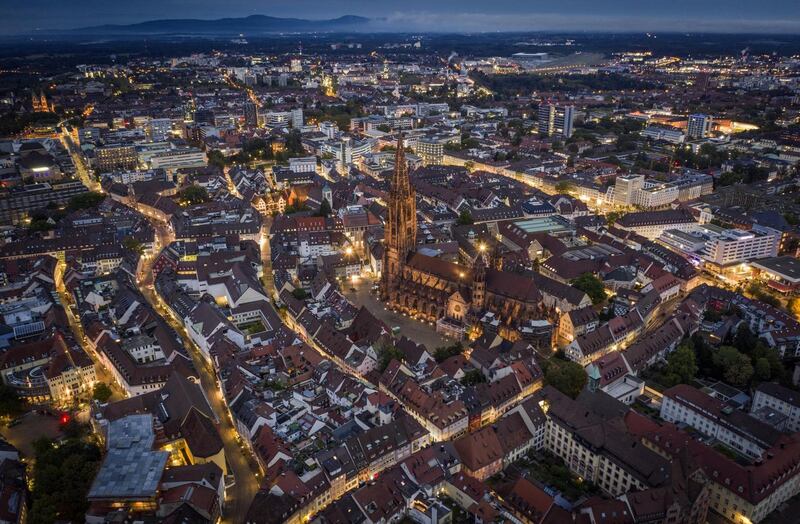

The fundamental idea is to concentrate future growth within a new orbital road around the city that would set a limit on its outer development. (An Bord Pleanála has approved a ring road, but the plan is currently the subject of High Court judicial review proceedings.)
In the 2070 plan, motorists bound for a new central pedestrianised zone in the city would transfer to bikes or buses at six park-and-ride stops inside the orbital route, the road itself being surrounded by a greenway and cycle network.
Housing would change over time as Galway adopts increased-density compact designs instead of moving outwards to new greenfield sites. Public landbanks and empty spaces in residential areas would be deployed for housing, and new buildings would be taller than the obsolete homes they replace. But an “extended green network” of parks, recreational open spaces and motor-free streets would boost sustainability.

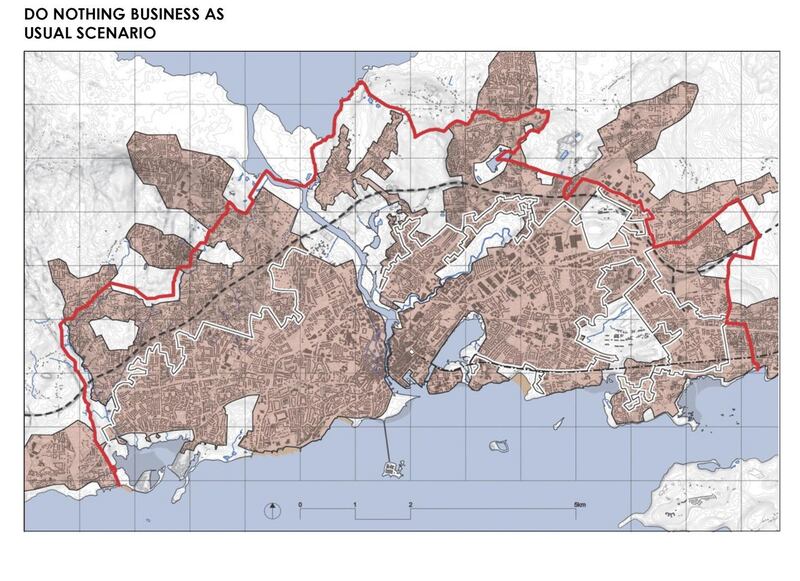

The group also believes that three new villages can be built on the city’s eastern coastline, benefitting from appealing views of Galway Bay and using the proximity to the Dublin rail line as an obvious link to the urban centre.
There is no political mandate for the 2070 Galway project. It stands apart from the regular six-year cycle of local authority development plans, the latest of which is currently under discussion. It is also separate also from the Government’s national development plan, Project Ireland 2040.
“It’s our vision of what’s possible and it’s for the wider society of Galway to decide whether this is their future. So we’re just taking a somewhat dispassionate view,” says David Browne, another leading light in the 2070 group.
At root, the masterplan marks an effort to spur debate about Irish cities in a future in which more and more people will be living in the State. In the past, Irish leaders have shown how visionary policies can guide huge advances in the education system and the evolution of a successful economic model driven by foreign direct investment. But truly far-sighted thinking has not been much in evidence in the development of Irish cities, with poor planning all too evident when it comes to housing, transport and infrastructure.


If Irish cities are to avoid splitting at the seams, the need for such thinking will become ever more pressing in years to come. Official projections suggest the State’s population, which rose above five million last year for the first time, will hit six million by 2050 – and will keep on rising for decades.
“The population of Ireland got smaller and smaller and smaller in each census until 1966,” says Coady, who qualified 53 years ago and established his own firm in the 1980s. “We lost all of the skills of city- and town-building because we weren’t doing any of it. We didn’t need it. We’re reaping the consequences of that kind of thinking right here and now, and we have to reverse it.”
Data suggest the population of Galway city and suburbs is on track to grow by between 40,000 and 48,000 by 2040 from close to 80,000 at present, an increase of 50-60 per cent. But Coady’s work with Browne assumes the city could be in line for considerably greater growth when taking in the years all the way out to 2070.
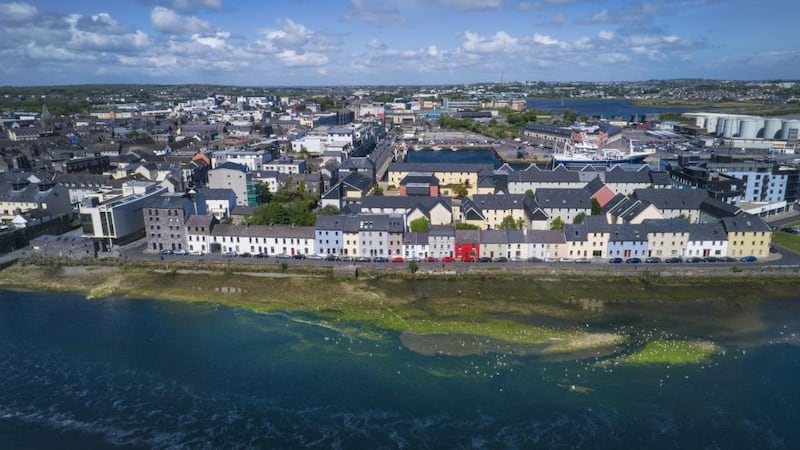
“Since 1970 the city has tripled in size and that’s all driven, of course, by industrial development. In 1970 it was 29,000 and now it’s 79,000. Our demographer feels that it has the capacity to triple in size in the next 50 years,” says Browne, chairman of RKD Architects and a former RIAI president.
This heralds serious and growing pressure on Galway for decades to come. The city’s “extremely low” population density of 13 dwellings per hectare makes it a European outlier, well below cities elsewhere with 300 or even 400 dwellings per hectare. If the density does not increase, Browne says Galway simply won’t be able to grow without creating chaos in its hinterland. But even a doubling of density overall won’t be enough.
“If we expand it at twice the density – in other words, 26 units per hectare – the city is just going to balloon out and it probably would become untenable.”
Such constraints – all too real in the minds of city leaders – are well-recognised locally. “There are challenges,” says NUI Galway president Ciarán Ó hÓgartaigh. He has been briefed on the 2070 plan and sees it as a coherent framework for looking to the city’s future, saying the task requires an imaginative leap. “It’s not an administrative barrier, more a barrier of imagination.”
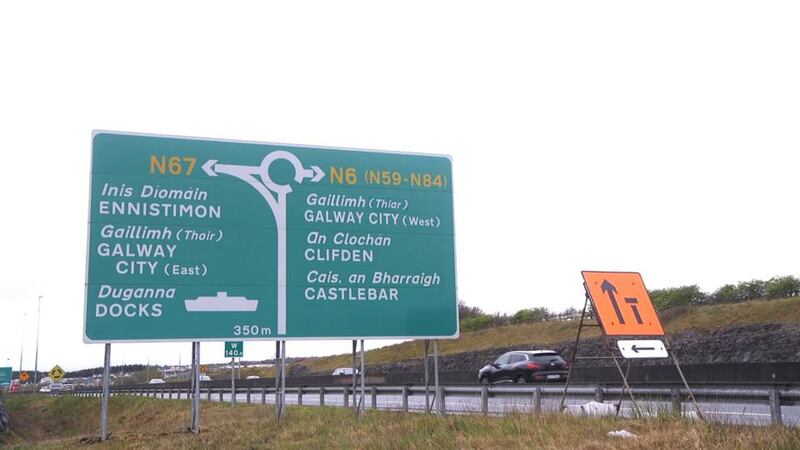
Ó hÓgartaigh says the potential prize for Galway is to have people living within 20 minutes of work, amenities and services. “It’s a very old city centre for sure and in order to plan ahead within the city boundaries, or to avoid urban sprawl and suburban sprawl, we need to think about what happens in the city itself and within the existing suburbs.
“The growth has been mainly, up until recently at least, in the suburbs and that has posed challenges for infrastructure of all kinds, transport [and] schooling. This also gives us an opportunity to think how we are going to plan for a European city like Freiburg, or others which are well- planned.”
'We want to be that modern sustainable urban core, culturally diverse which we are, but actually to build more on that'
At the same time, business people warn that any failure to confront Galway’s problems could threaten the flow of global business into the city. More than 70 international client companies of IDA Ireland have operations in Galway, making it a hub for inward investment with big spin-off benefits for local commerce. The 520 member companies in Galway Chamber employ some 28,000 workers.
If the city’s future is a high-stakes matter for their prospects, it is crucial also for the State’s strategic drive to rebalance economic development away from Dublin into the regions.
But Galway business people quietly acknowledge anxiety over the city’s capacity to keep pace with job creation, saying its “natural X factor” must be complemented by basic infrastructure in terms of housing and transport. At issue primarily is the availability of decent accommodation as Galway expands, a question critical to the city’s desirability as a place to live.
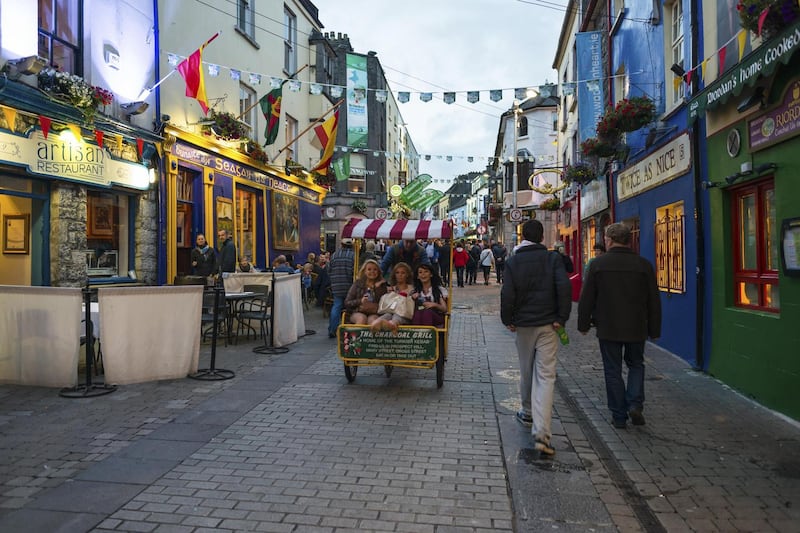
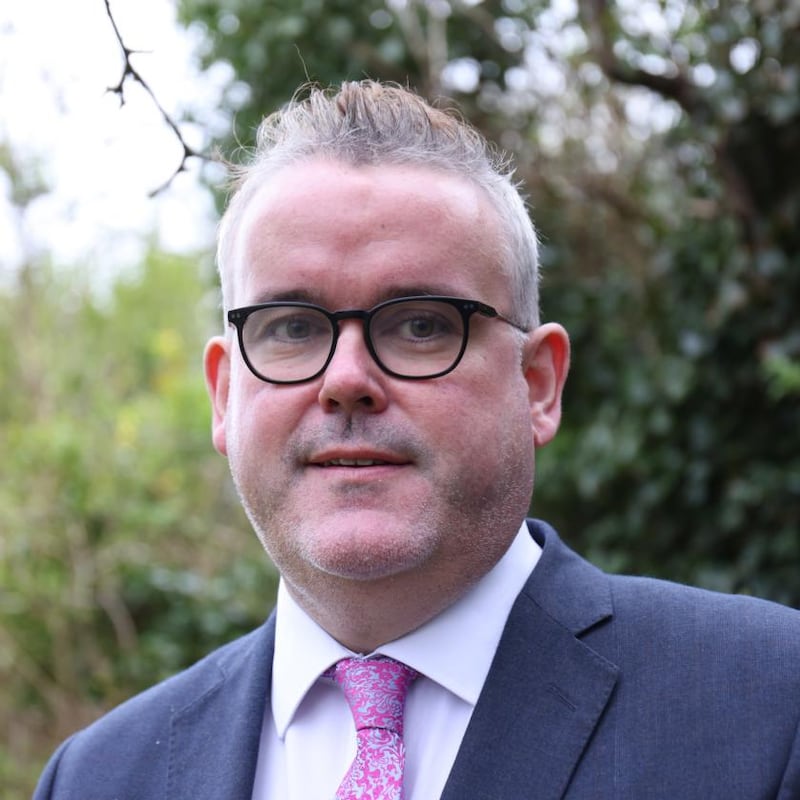
“We would feel that Galway has phenomenal potential for growth,” says a high-level figure familiar with the views of tech investors in the city. “There’s a strong track record. There’s a strong pipeline. The concern would be that we could actually execute that pipeline – and the primary concern would be that people would struggle to find the appropriate accommodation etc and therefore the whole thing starts spiralling downwards.”
Kenny Deery, chief of Galway Chamber, is taken with the 2070 vision for the city, saying it chimes well with local views. “The research and the work that has taken place by the architects actually reinforces a lot of what we knew already. But it brings external validation and credibility from a group of professionals.”
Yet if long-range thinking is one thing, action is quite another. For all his upbeat enthusiasm for the “magic” of Galway – which he describes as a city and a big town at the same time – Deery says the place needs to do more when it comes to completing major works. If fixing the city to make it fit for the future is the biggest of all projects, this is a problem that keeps him awake at night.
“We want to be that modern sustainable urban core, culturally diverse which we are, but actually to build more on that. But to do that we need to ensure some pain now on the delivery of infrastructure.”
THREE BIG IDEAS TO IMPROVE GALWAY
A Renmore rethink
With almost 3,000 people living in some 1,200 homes, the suburb of Renmore is typical of Galway’s low-density housing. Architect Jim Coady says doubling the area’s density from 17 to 34 dwellings per hectare “is about the lowest that we think is viable” in the long term, meaning the population would rise significantly in coming decades. So how can that be achieved?
The plan centres on playing fields surrounded by housing south of the Bon Secours Hospital complex. “We see this as a potentially very fine amenity that as people come in greater numbers becomes more intensely used,” Coady says.
He sees room to incrementally grow the amount of housing land, saying the current 70 hectares (173 acres) can be expanded over decades to 95 hectares (235 acres). Higher densities mean Renmore could eventually accommodate some 7,780 people. The area already has a community centre, a primary school and a church, but “better community facilities” will be needed as it grows.
“Unlike former urban redevelopment, you’re not going in and pulling down a whole neighbourhood. You’re actually trying to supplement it,” says David Browne, an architect who worked with Coady on the plan.
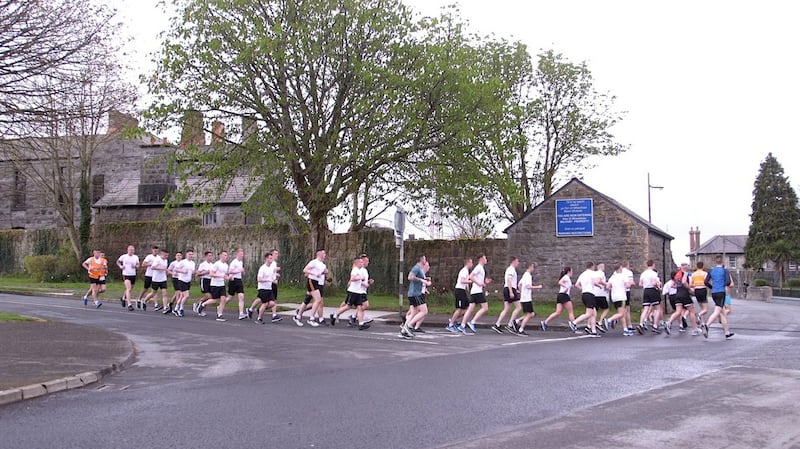
Knocking down walls to increase access between existing residential areas would provide space for 39 new dwellings. Another 49 dwellings could be built on vacant corner sites. A further 177 could be built on empty “backlands” between homes. He also sees room for 343 dwellings with three- or four-storey apartments in “green edges” by the playing fields and the rail line south of Renmore.
There is room for 864 new dwellings via “infill” development on large open sites, and by compressing school sites by building upwards. Rebuilding 300 homes that will become obsolete in future decades could be done at twice or three times the density, opening scope for more than 600 new dwellings.
Reviving the city centre
The Galway 2070 plan assumes the city can develop around its medieval core in future decades, but with higher densities in the central zone and considerably less motor traffic.
“The strategy we’re thinking of is that we need to consolidate around the city because if it’s going to triple in size, you’re going to need a bigger city centre,” says Browne. “A big first move for Galway would be to be much more radical in pedestrianising the centre,” he adds, saying it could transform the look and feel of the city.
Fewer people would drive in a pedestrian-dominant centre and there would be better electric bus access via six new park-and-ride stations on the city boundaries. Browne therefore sees scope to relocate big out-of-town retailers into the multi-storey car parks that today are dotted around the inner city and would be less used in the future.
With out-of-town retail discouraged over time, the plan suggests large single-storey shop buildings in areas such as the Headford Road could be redeveloped upwards. Such buildings would rise up to eight storeys for offices, residential and student housing although the same retail space could be kept at ground level. It also calls for a public indoor market in the area, like the English Market in Cork

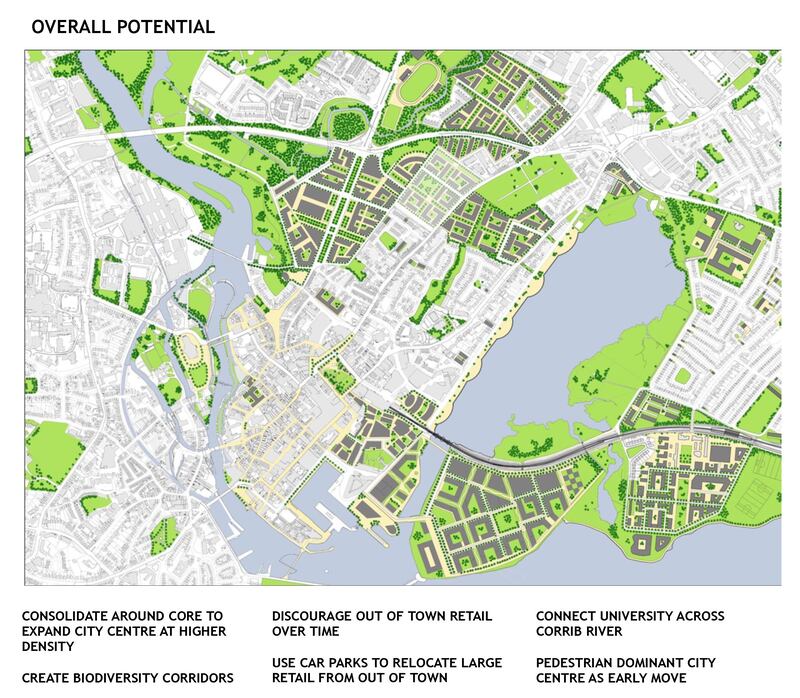
Browne notes vibrant tourism in Galway but says the “cultural offer” should be revived, arguing it was at its height 20 years ago.
“We’ve mapped the existing character areas within the inner city and the existing cultural venues and we think they’re a great framework for strengthening the city centre over time,” he says.
“In the very centre city, there are no significant development sites. It’s quite densely developed and there’s an intact – if faltering – combination of buildings in public realm. They do need [tender loving care].”
He foresees better connections to University College Galway over the Corrib river, as well as extended parks and more cycleways linking to biodiversity corridors around the city.
Three new villages
To boost Galway’s growth potential, the 2070 group says three new coastal villages can be built on its eastern shores by the Dublin railway.
This long-term plan would be similar to the Dublin docklands plan that changed the Liffey quays. By building within Galway’s urban boundaries, the new villages would relieve strain on its rural hinterland as the city grows.
The land is in public and private hands. Current uses include Defence Forces barracks and oil distribution from Galway port. There is also a pitch-and-putt course and playing pitches.
“In our view the local authority will be buying up the whole of this land and then putting in the infrastructure,” says Coady. He has an open mind on who might build the Murrough, Docklands and Barracks neighbourhoods, saying the work could be done by co-operatives, developers or the local authority.
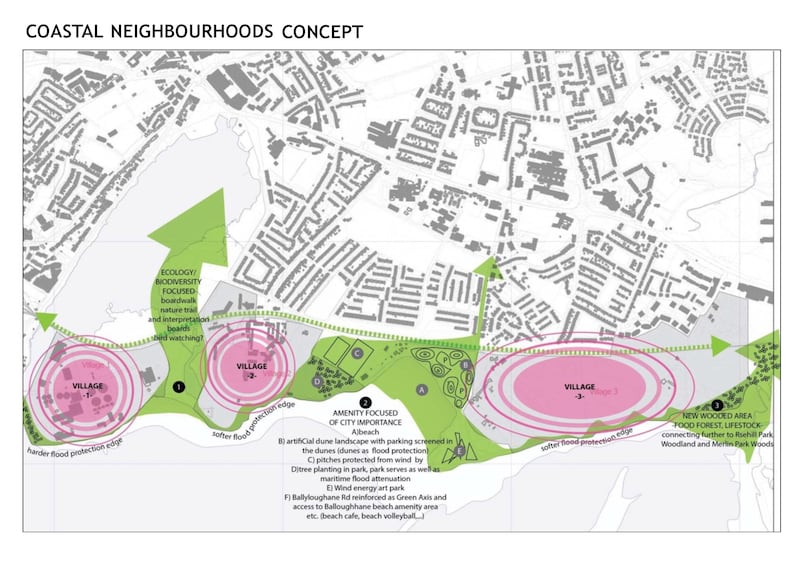
Still, he says compact housing can provide the increased density that Galway needs for orderly growth. The locations open scope for three rail commuter stations into Galway as an additional track is added to the single-line railway, but also to build schools and businesses locally so residents won’t have to commute. Bus links to other city locations would also be in prospect.
The areas fronting the sea in the Murrough area would be a car-free area for cycling or promenading, and possibly a diving board similar to Salthill in the west city. Residents could drive to their front door to unload groceries. But to save space they could park only in a dedicated multi-storey building locally.
The plan foresees port activity replaced by six- and eight-storey residential blocks and commercial space. While the barracks buildings would be retained as a new district centre, four-storey residential housing on the site could provide density of between of 100 and 120 dwellings per hectare.









